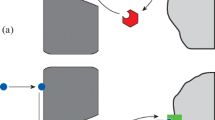Summary
-
1.
Two types of Sensilla coelosphaerica have been found on the terminal antenna segment of the carrion beetle,Necrophorus vespilloides, about 1800 Typ I and 1400 Typ II sensilla (Table 1).
-
2.
Eleotrophysiological examination has shown the presence of a cell in Type I sensilla which responds to the odor of carrion. This cell differs from carrion receptors in Sensilla basiconica studied so far in that it reacts to H2S and a few cyclic compounds (Table 2).
-
3.
With the amputation of the terminal segment of both antennae, Necrophorus ceases to orient to carrion, even though 90% of the receptors responding to carrion odor are still functional. These are located in the Sensilla basiconica of the remaining segments (about 15000 per antenna) (Table 3).
-
4.
On the other hand, when the fields of Sensilla basiconica are eliminated and the sensilla of the terminal segments are intact,Necrophorus does orient to carrion (Table 4).
-
5.
The attractivity of carrion odor for the beetle is not simply the result of excitation of the carrion receptors of the Sensilla basiconica. It is quite possible that the newly found carrion receptor in the Sensilla coelosphaerica is responsible for the coding of the odor of rotten meat.
Zusammenfassung
-
1.
Auf dem distalen Antennensegment des TotengräbersNecrophorus vespilloides finden sich ca. 1800 coelosphaerische Sensillen vom Typ I und ca. 1400 coelosphaerische Sensillen vom Typ II (Tabelle 1).
-
2.
Zellen vom Typ I antworten im elektrophysiologischen Experiment auf Aasgeruch. Sie reagieren außerdem auf H2S und einige cyclische Verbindungen, wodurch sie sich von dem anderen bereits bekannten Aasgeruchrezeptor in den basieonischen Sensillen unterscheiden (Tabelle 2).
-
3.
In Verhaltensversuchen findetNecrophorus nach Amputation des letzten Segmentes beider Antennen nicht mehr zum Aas, obwohl noch 90% der Aasgeruehrezeptoren in den basieonischen Sensillen (ca. 15000 pro Antenne) auf den restlichen Segmenten vorhanden sind (Tabelle 3).
-
4.
Allein mit dem Rezeptorinventar des letzten Segmentes einer Antenne ohne das dort befindliche Feld basiconischer Sensillen mit Aasgeruchrezeptoren findetNecrophorus zum Aas (Tabelle 4).
-
5.
Die Erregung der Aasgeruchrezeptoren in basieonischen Sensillen ist also keine Voraussetzung dafür, daß Aasduft auf die Käfer anlockend wirkt. Der neu gefundene Aasgeruchrezeptor in den coelosphaerischen Sensillen ist möglicherweise für die nervöse Codierung von Aasgeruch entscheidend.
Similar content being viewed by others
Literatur
Abbott, C.E.: Experimental data on the olfactory sense of Coleoptera, with special reference to the Necrophori. Ann. Entomol. Soc. Amer.20, 207–216 (1927a).
Abbott, C.E.: Further observations on the olfactory powers of the Necrophori. Ann. Entomol. Soc. Amer.20, 550–553 (1927b).
Boeckh, J.: Elektrophysiologische Untersuchungen an einzelnen Geruchsrezeptoren auf den Antennen des Totengräbers (Necrophorus, Coleoptera). Z. vergl. Physiol.46, 212–248 (1962).
Boeckh, J.: Reaktionsschwelle, Arbeitsbereich und Spezifität eines Geruchsrezeptors auf der Heuschreckenantenne. Z. vergl. Physiol.55, 378–406 (1967a).
Boeckh, J.: Inhibition and excitation of single insect olfactory receptors and their role as a primary sensory code. II. Int. Symp. Olfaction and Taste (Hayashi, T., ed.), p. 721–735. Oxford: Pergamon Press, 1967b.
Boeckh, J., Kaissling, K.E., Schneider, D.: Insect olfactory receptors. Cold Spr. Harb. Symp. quant. Biol.30, 263–280 (1965).
Ernst, K.-D.: Die Feinstruktur von Riechsensillen auf der Antenne des AaskäfersNecrophorus (Coleoptera). Z. Zellforsch.94, 72–102 (1969).
Ernst, K.-D.: Sensillum coelosphaericum, die Feinstruktur eines neuen olfaktorischen Sensillentyps. Z. Zellforsch.132, 95–106 (1972).
Kaib, M.: In Vorbereitung (1973).
Kaissling, K.-E.: Insect olfaction. In: Handbook of sensory physiology, H. Autrum, R. Jung, W.R. Loewenstein, D.M. MacKay, H.L. Teuber, eds., vol. IV: Chemical senses, part 1: Olfaction (L. M. Beidler, ed.) 351–431. Berlin-Heidelberg- New York: Springer 1971.
Lacher, V.: Elektrophysiologische Untersuchungen an einzelnen Rezeptoren für Geruch, Kohlendioxyd, Luftfeuchtigkeit und Temperatur auf den Antennen der Arbeitsbiene und der Drohne (Apis mellifica L.). Z. vergl. Physiol.48, 587–623 (1964).
Sass, H.: Das komplexe Zusammenspiel mehrerer Rezeptortypen bei der nervösen Codierung von Futtergerüchen. Verh. dtsch. Zool. Ges. Mainz66, 198–201 (1972).
Author information
Authors and Affiliations
Rights and permissions
About this article
Cite this article
Waldow, U. Elektrophysiologie eines neuen Aasgeruchrezeptors und seine Bedeutung für das Verhalten des Totengräbers (Necrophorus). J. Comp. Physiol. 83, 415–424 (1973). https://doi.org/10.1007/BF00696356
Received:
Issue Date:
DOI: https://doi.org/10.1007/BF00696356




